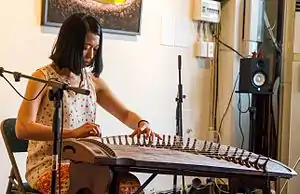Jung Mina 정민아 | |
|---|---|
 Jung performing at an art gallery in July 2013 | |
| Background information | |
| Born | January 31, 1979 Seoul, South Korea |
| Occupation(s) |
|
| Years active | 2005–present |
| Korean name | |
| Hangul | |
| Revised Romanization | Jeong Min-a |
| McCune–Reischauer | Chŏng Min-a |
Jung Mina (born January 31, 1979) is a South Korean musician, known as the first gayageum singer-songwriter.[1][2] She sings contemporary music and uses non-traditional techniques in her gayageum playing.[3]
Early life and career
Jung started learning to play the gayageum, a traditional Korean string instrument, at 12 years old. She said it became a big part of her life, so she continued to play it as she developed her music career.[3] She found the instrument when she started taking traditional Korean dance in elementary school. From her second year in middle school she started lessons with a neighborhood teacher, then studied at Gukak National High School, Hanyang University, and Sookmyung Women's University.[4]
She worked various part-time jobs during school and after starting her musical career, including in the ticket office of a racecourse on the weekends for four years, and at a call center, like many of her friends.[5] She said making a living with music was difficult. During a leave from graduate school, a club owner in Hongdae, where she was working part-time, convinced her to start composing and performing on stage.[4] Even after releasing her first album, she returned to part-time work, selling rice balls near Gwanghwamun Station, but soon gave up, admitting that she was not skilled at the work.[4] One of her ballads, "Jumeokbab", or "Rice Balls" was about her work experience.[6] She said, "If I didn't have these experiences, I wonder whether I could have written the music I did, because the only thing I knew was traditional Korean music. I think I would be making only shallow and superficial music."[4] She has said she differs from many musicians, in choosing to write her lyrics first, and the melodies afterwards.[3]
She worked in Hongdae for five years, becoming popular as a fusion indie musician, known as the first with a gayageum to perform there on a regular basis.[6] She uses a 25-string variant of the original 12-string gayageum, to give variations in the range of notes, and incorporates her Western music theory and jazz training in her compositions.[6][7]
Debut and albums
In 2005, she debuted with her first extended play (EP), Tragedy.[3] In 2006, she released her first studio album, Love Dream,[6] which sold over 10,000 copies. One of the tracks on the album was included in a middle school music textbook.[4] Her second studio album, Afterimage, was released in March 2010. It was described as "[forging] contemporary sounds that successfully blend traditional instrument's sounds with bass guitar rhythms."[6] She released her fourth, A Person's Moment, in January 2014.[3] She wrote the lead track "Poor Woman" for the album after browsing through random books in a Seoul library. This led to her traveling across the country for more inspiration, visiting more libraries, and sleeping in jjimjilbangs to meet the people of the different regions.[3]
Film documentary
A documentary was made of her and her band on a 15-day busking tour in 2009, titled Fantastic Journey of The Modern Gayagumer. It was released on August 18, 2011, after screening at the Jecheon International Music & Film Festival earlier in August.[1][4][8]
Awards and nominations
In 2012, as an artist, she charted in the number one position on the Billboard chart "Next Big Sound", a weekly chart of the "fastest accelerating artists during the past week, across all major social music sites, statistically predicted to achieve future success."[9]
| Year | Award | Category | Nominated work | Result | Ref. |
|---|---|---|---|---|---|
| 2008 | Korean Music Awards | Newcomer Award | Nominated | [5] | |
| 2011 | Korean Music Awards | Best Jazz & Crossover Album | Afterimage | Nominated | [10] |
| 2015 | Korean Music Awards | Best Crossover Album | A Person's Moment | Nominated | [11] |
Discography
EPs
Studio albums
References
- 1 2 "Fantastic Journey of The Modern Gayagumer (2011)". KoBiz. Korean Film Council. Retrieved June 1, 2016.
- ↑ Jeong, Sang-young (March 3, 2014). ‘가야그머’ 정민아 “내게 가야금은 어쿠스틱 기타”. The Hankyoreh (in Korean). Retrieved June 1, 2016.
- 1 2 3 4 5 6 7 8 Jackson, Julie (February 25, 2014). "Jung Mina looks to usher in modernized sounds of the gayageum". The Korea Herald. Retrieved June 1, 2016.
- 1 2 3 4 5 6 "A Rising Star on the Gayageum". The Chosun Ilbo. September 3, 2011. Retrieved June 1, 2016.
- 1 2 Lee, Jong-won (July 5, 2011). "'인디형 가야금 싱어송라이터' 정민아 "이젠 진짜 음악만 하고 싶어요"". Seoul Shinmun (in Korean). Retrieved June 1, 2016.
- 1 2 3 4 5 6 7 Chung, Ah-young (April 14, 2010). "Traditional Musician Forges New Sounds, Emotions". The Korea Times. Retrieved June 1, 2016.
- ↑ "Modern Gayageum: Jung Mina Concert". Korea.net. Retrieved June 1, 2016.
- ↑ Kim, Hee Joo (August 12, 2011). "JIMFF11│정민아 "천재가 아니어도, 1인자가 아니어도 충분히 행복하다"". Ten Asia. Retrieved June 1, 2016.
- ↑ "Billboard Magazine, Next Big Sound - 2012-05-26, p. 40" (PDF). www.americanradiohistory.com. Retrieved September 15, 2019.
- ↑ 한국대중음악상 시상식에 독자 여러분을 ‘왕창’ 모십니다. The Hankyoreh (in Korean). February 18, 2011. Retrieved June 1, 2016.
- ↑ "Nominees for 12th Korean Music Awards". Indieful ROK. February 3, 2015. Retrieved June 1, 2016.
- ↑ "Jung Mina Modern Gayagumer". Keystone Live. Retrieved June 1, 2016.